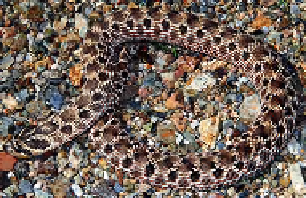Biology Reference
In-Depth Information
Species
Hazard Index
a
Management Recommendations
b
Western hognose snake,
H. nasicus
3
Observation as deemed clinically necessary in order to rule out any
significant sequelae. This is important as although there are no data to
support very serious sequelae from many genera (including
Philodryas
spp.), the possibility of such effects exists. Rare cases of widespread
ecchymoses suggesting systemic effects have occurred following
P.
olfersii
bites. Therefore, bites from larger specimens or protracted bites
should be carefully reviewed.
DO NOT GIVE ANTIVENOM OF ANY KIND. There are no
antivenoms against these snakes and there are no data supporting any
cross-neutralization from any poly- or monovalent antivenom. Due
to this as well as the obvious high risk:low benefit profile, the use of
antivenom is contraindicated for any of these snakes.
Close follow-up as indicated.
Several other assorted taxa [
Alsophis
(
Borikenophis
)
portoricensis
,
Platyceps
rhodorachis
, etc; see Table 4.1]
3
Careful verification of the identity of the snake and documentation of
the case are integral.
Abbreviations: ABC, airway, breathing, circulation, and associated emergency measures; ARF, acute renal failure; APTT, partial thromboplastin time; CBC, complete blood count; CK,
creatine phosphokinase; CMP, complete metabolic panel; CT, CAT scan; DIC, disseminated intravascular coagulation; FFP, fresh-frozen plasma or cryoprecipitate; ICU, intensive care unit;
INR, international normalized ratio; NICU, neonatal intensive care unit; PICU, pediatric intensive care unit; PRBCs, packed red blood cells; PT, prothrombin.
a
Hazard Index is defined following a modification of the criteria of Weinstein et al. (2009): Level 1—serious and potentially fatal envenoming is possible; Level 2—systemic envenoming is
possible, but uncommon; Level 3—usually mild-to-mildly moderate local effects and often related to protracted bite.
b
The representative species and recommendations for management listed here were selected due to the availability of data sufficient to assess the potential medical significance of bites
inflicted by each taxa. Due to the limited number of documented cases involving most of these and the majority of “colubrid” species, this assessment and management recommendations
can only be considered a preliminary guide and should not be considered a fully inclusive list.
c
Antivenom: Anti-
D. typus
antivenom is only available from the South African Vaccine Producers (SAVP; 1 Modderfontein Road, Sandringham, Johannesburg, South Africa, Tel.:
27 11
882 9940; fax:
27 11 882 0812; E-mail:
savpunit@global.co.za
/
savpqual@global.co.za
,
web site:
www.savp.co.za
). Anti-
Thelotornis
spp. antivenom is not available. Anti-
R. tigrinus
antivenom is only available from the Japan Snake Institute, Yabuzuka-honmachi Nittagun, Gunma Prefecture 379-2301, Japan, Tel.:
81 277 78 5193; fax:
81 277 78 5520; E-mail:
snake-a@sunfield.or.jp
.
In any case of serious envenoming by these species, it is strongly advised to contact any available antivenom index center (in the USA, call 800-222-1222), Poison
Control Center and an experienced clinical toxinologist.
d
The photo depicts
Thelotornis mossambicanus
, while the map illustrates the range of
T. kirtlandii
. In addition to
T. capensis
and
T. kirtlandii
, other members of the genus such as
T.
mossambicanus
should be considered as probable hazard level 1 species.









